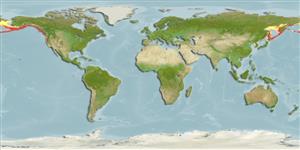Environment: milieu / climate zone / depth range / distribution range
Écologie
marin démersal; profondeur 0 - 450 m (Ref. 58496). Temperate; 66°N - 34°N
North Pacific: Kamchatka, Russia and along the Commander and Aleutian Islands to St. Paul Island in the Bering Sea and to Monterey Bay, California, USA.
Taille / Poids / Âge
Maturity: Lm ? range ? - ? cm
Max length : 51.0 cm TL mâle / non sexé; (Ref. 2850); poids max. publié: 1.1 kg (Ref. 40637)
Description synthétique
Clés d'identification | Morphologie | Morphométrie
Épines dorsales (Total) : 10 - 12; Rayons mous dorsaux (Total) : 18 - 20; Épines anales: 0; Rayons mous anaux: 13 - 16; Vertèbres: 35. Dorsal with moderate notches in the spinous part after the third spine, and between the spinous and rayed parts; caudal bluntly rounded; pelvic fins larger in males (Ref. 6885). Color variable, predominately red, sometimes brilliant red, with brown, white, and black mottling and spotting all over; there are four irregular dark saddles across back; the caudal fin with darker rays, sometimes with vertical light bars; some large males with darkly spotted pelvic fins (including base of pectorals) (Ref. 6885).
Usually near shore in rocky areas (Ref. 2850), from intertidal areas to 275 m depth (Ref. 6793). Adults feed on crabs, barnacles, and mussels (Ref. 6885). Good eating (Ref. 2850).
Life cycle and mating behavior
Maturities | Reproduction | Spawnings | Egg(s) | Fecundities | Larves
Eschmeyer, W.N., E.S. Herald and H. Hammann, 1983. A field guide to Pacific coast fishes of North America. Boston (MA, USA): Houghton Mifflin Company. xii+336 p. (Ref. 2850)
Statut dans la liste rouge de l'IUCN (Ref. 130435)
Menace pour l'homme
Harmless
Utilisations par l'homme
Pêcheries: commercial; pêche sportive: oui; Aquarium: Aquariums publics
Outils
Articles particuliers
Télécharger en XML
Sources Internet
Estimates based on models
Preferred temperature (Ref.
123201): 0.9 - 7.7, mean 4.4 °C (based on 386 cells).
Phylogenetic diversity index (Ref.
82804): PD
50 = 0.5156 [Uniqueness, from 0.5 = low to 2.0 = high].
Bayesian length-weight: a=0.00676 (0.00300 - 0.01523), b=3.17 (2.98 - 3.36), in cm total length, based on LWR estimates for this (Sub)family-body shape (Ref.
93245).
Niveau trophique (Ref.
69278): 3.5 ±0.6 se; based on diet studies.
Résilience (Ref.
120179): Très faible, temps minimum de doublement de population supérieur à 14 ans (Preliminary K or Fecundity.).
Fishing Vulnerability (Ref.
59153): Moderate vulnerability (40 of 100).
